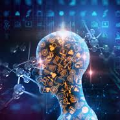At the intersection of computation and cognitive science, graph theory is utilized as a formalized description of complex relationships and structures. Traditional graph models are often static, lacking dynamic and autonomous behavioral patterns. They rely on algorithms with a global view, significantly differing from biological neural networks, in which, to simulate information storage and retrieval processes, the limitations of centralized algorithms must be overcome. This study introduces a directed graph model that equips each node with adaptive learning and decision-making capabilities, thereby facilitating decentralized dynamic information storage and modeling and simulation of the brain's memory process. We abstract different storage instances as directed graph paths, transforming the storage of information into the assignment, discrimination, and extraction of different paths. To address writing and reading challenges, each node has a personalized adaptive learning ability. A storage algorithm without a God's eye view is developed, where each node uses its limited neighborhood information to facilitate the extension, formation, solidification, and awakening of directed graph paths, achieving competitive, reciprocal, and sustainable utilization of limited resources. Storage behavior occurs in each node, with adaptive learning behaviors of nodes concretized in a microcircuit centered around a variable resistor, simulating the electrophysiological behavior of neurons. Under the constraints of neurobiology on the anatomy and electrophysiology of biological neural networks, this model offers a plausible explanation for the mechanism of memory realization, providing a comprehensive, system-level experimental validation of the memory trace theory.
翻译:暂无翻译





